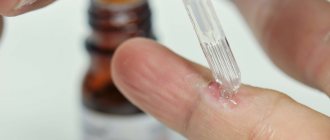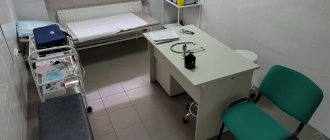Pharmacodynamics and pharmacokinetics
Glycine is an aminoacetic acid , usually found in almost all tissues of the body, most of all in the brain and spinal cord. Participates in many metabolic processes, in particular it is an important neurotransmitter . Takes part in the process of transmission of nerve impulses, blockade of alpha-adrenergic receptors . Also, the active substance takes part in the synthesis of proteins and other bioactive elements, strengthens the membrane of nerve fibers - neurons . Thus, tension decreases and neurons become less sensitive to the effects of toxins .
The drug also acts as a nootropic . It increases the number of electrical impulses in various parts of the brain, memory and thinking processes improve, and the speed of psychomotor reactions increases. In this regard, Glicised is prescribed for mental and physical fatigue.
The drug has the ability to reduce the toxic effects of various psychotropic substances by reacting with them and neutralizing them. For example, glycine reacts with phenol , converting it to hippuric acid .
Sublingual administration is considered the most effective . It does not accumulate in body tissues; it is metabolized to inactive substances.
Characteristics Glycised tab, 100 mg N50
- Active ingredient: Glycine
- Release form: tablets
The drug Glycised (the active ingredient is the amino acid glycine) belongs to the group of sedatives.
As medical practice confirms, glycine has anti-stress, nootropic, stress-protective and actitoxic effects.
Due to the high level of safety, both adults and young patients (from 3 years old) can receive a recommendation to buy Glycised tablets at the nearest pharmacy.
Indications.
The list of indications for taking Glycised is quite wide.
The main ones include diseases of the nervous system - neuroses, neuroinfections, encephalopathy, vegetative-vascular dystonia, consequences of traumatic brain injury.
Patients who have suffered a stroke, as well as people suffering from epilepsy (taking Glycised allows you to reduce the dose of antiepileptic drugs) can receive advice to order Glycised.
Patients with alcohol dependence are also well aware of this drug, because it is considered a safe and effective anti-hangover remedy.
The decision to book Glycised will also be advisable for depression, insomnia, mental exhaustion and memory impairment.
Naturally, in each case it is necessary to consult a doctor.
Application.
The duration of treatment and dosage of Glycised will vary depending on the age and condition of the patient.
The standard prescription is one tablet 1-3 times a day for 1-4 weeks.
If necessary, the course is repeated up to 6 times a year.
Contraindications.
Any patient who does not have individual glycine intolerance can reserve Glycised tablets.
People with low blood pressure should take this drug with caution.
Indications for use
Glycised tablets are prescribed for disorders of the nervous system:
- in case of cerebral circulatory disorders ;
- for traumatic brain injuries ;
- for neurocirculatory dystonia ;
- encephalopathy of various origins;
- in conditions after previous infections and infectious diseases of the brain ;
- asthenia , withdrawal symptoms after drinking alcohol;
- with physical or mental overload;
- to improve memory and sleep quality, treat depression .
Frequently asked questions about Glycised
What is Glitsed from?
Diseases of the nervous system: neuroses, neurosis-like conditions, traumatic brain injury, encephalopathy, vegetative-vascular dystonia, sleep disturbance, excitability, depression of brain function, emotional instability, cerebrovascular accident, adjuvant for the treatment of alcoholism.
How to take Glycised?
The drug is taken sublingually (under the tongue) or transbucally (a crushed tablet is placed in the mouth or behind the cheek). Glycised is recommended for children over 3 years of age and adults in a dosage of 1 tablet 2-3 rubles/day. The duration of treatment depends on the disease.
Where can I buy Glycised?
You can purchase Glycised in the 911 pharmacy network at an affordable price or on the official website apteka911.ua where you can see the availability of the drug and its analogues in the nearest pharmacies of the network, select auxiliary products, personal hygiene and care products, book or arrange delivery to the nearest post office, etc. protecting your health from contact with sick people.
Instructions for use of Glycised (Method and dosage)
According to the instructions for Glycised, it is taken sublingually or buccally .
As a rule, children (from 3 years old) and adults are prescribed 1 tablet 3 times a day. The course of treatment ranges from two weeks to a month. The maximum amount of the drug taken per day is 0.3 grams.
For insomnia , take a tablet or half a tablet 20 minutes before bedtime.
When treating alcoholism , as part of complex therapy, take 3 tablets per day. The course is from two weeks to a month, repeated every 2-3 months.
In case of a stroke, the victim should be given 1 gram of Glycised within the first 3-6 hours. The next 5 days - 1 gram of the drug per day, 30 days - 600 mg per day.
Glitsed
Name: Glicised Pharmacological action: Glitsed has a mild sedative, nootropic and anti-anxiety effect. The active component of the drug is glycine, the simplest substance of the amino acid group. Glycine is an aminoacetic acid that has no optical isomers. Glycine is found in almost all tissues of the body, with the highest concentrations found in the tissues of the spinal cord and brain. In the body, glycine plays the role of a neurotransmitter, in particular, it has an alpha1-adrenergic blocking effect and is involved in impulse transmission in glycinergic and GABAergic synapses. In addition, the drug, thanks to its simple formula and wide range of chemical activity, is involved in the synthesis of proteins and physiologically active substances, including hippuric and glycocholic acids, porphyrins and purine bases. Glycine has a neuroprotective effect due to its ability to reduce the excessive effect on neurons of catecholamines, the release of which is accompanied by stress of various etiologies. In addition, glycine is the starting material for the synthesis of lecithin, the main component of phospholipids. Thus, by strengthening the neuron membrane, the drug helps to increase the resistance of neurons to the effects of toxins.
Under the influence of the drug, psycho-emotional reactions are weakened, a person’s ability to socially adapt increases, irritability, aggressiveness and increased conflict are reduced. In addition to the tranquilizing and sedative effect, the drug has a pronounced nootropic effect. Moreover, after taking the drug, there was an increase in electrical activity equally in the frontal and occipital regions of the brain and, as a result, an increase in patients’ concentration, an increase in the speed of computational operations and psychomotor reactions. Considering this effect of glycine on the human body, it is prescribed for intellectual and physical fatigue to improve performance, memory and normalize sleep.
In addition to the nootropic, sedative and tranquilizing effects, glycine has an antitoxic effect in intoxications of various etiologies, including alcohol intoxication. The mechanism of the antitoxic action of glycine is based on its ability to interact with various chemicals that have a toxic effect on the human body. As a result of chemical reactions, substances that are safe for the body are formed. Glycine is most effective for phenol poisoning, since the glycine molecule actively interacts with phenol molecules to form non-toxic hippuric acid. Glycine is also effective in drug poisoning, especially drugs that have a psychotropic effect. The greatest bioavailability is observed when taking the drug sublingually. Glycine penetrates well into all biological fluids of the body and creates high concentrations in the brain fluid. The drug breaks down in the liver to inactive components and does not accumulate in the body.
Indications for use: The drug is used for various diseases of the nervous system, regardless of etiology, including: - cerebrovascular accidents of various origins; - infectious diseases of the nervous system, deterioration of nervous system function after infections; - traumatic brain injury; — encephalopathy of various origins, including perinatal encephalopathy and alcoholic encephalopathy; — in addition, the drug is used for asthenic conditions, neurocirculatory dystonia, and alcohol withdrawal.
Glitsed is indicated for mental exhaustion, to increase intellectual capacity, improve memory, and increase the ability to perceive information. The drug is used in combination with other medications for psycho-emotional stress, depression, sleep disorders, and increased irritability. To reduce cravings for alcohol.
Directions for use: The drug is administered sublingually, regardless of meals. Adults with intellectual and psycho-emotional overstrain, memory loss and deviant forms of behavior are usually prescribed 1 tablet of the drug 2-3 times a day. The course of treatment is from 15 days to 1 month. For asthenia, I prescribe the drug 2 tablets 3 times a day. The course of treatment for asthenic conditions is up to 30 days. For sleep disorders, 1 tablet of the drug is usually prescribed 20 minutes before bedtime. The course of taking the drug is up to 30 days. For alcoholism, to reduce cravings for alcohol and withdrawal symptoms, 1 tablet of the drug is prescribed once. If necessary, the drug can be repeated after 10-15 minutes. The daily dose should not exceed 600 mg of glycine.
Repeated courses of drug therapy are carried out 4-6 times a year if indicated. Children over 3 years of age and adolescents with increased excitability and sleep disorders are prescribed 1 tablet of the drug 2-3 times a day. The duration of taking the drug is 1-2 weeks. Children with mental retardation and asthenia are prescribed 1 tablet of the drug 2-3 times a day for 15-30 days. If there are indications, a second course of treatment with the drug is possible.
Side effects: The drug in recommended doses is well tolerated by patients. If the dose of the drug was exceeded or hypersensitivity to glycine, patients experienced side effects such as nausea, itching, rash, urticaria, and headache.
Contraindications: Increased individual sensitivity to the components of the drug. Prescribe the drug with caution to patients with arterial hypotension. The drug in the form of sublingual tablets is not used to treat children under 3 years of age.
Pregnancy: There are no data on the safety of the drug during pregnancy and lactation. The drug is used only for health reasons and under the strict supervision of the attending physician.
Interaction with other drugs: When used simultaneously, the drug reduces the toxic effect of anticonvulsants and antidepressants on the body. When used simultaneously, it enhances the effect of tranquilizers and sleeping pills.
Overdose: At the moment, there are no data on overdose of the drug.
Release form: Sublingual tablets, 10 pieces in a blister, 5 blisters in a cardboard package.
Storage conditions: It is recommended to store the drug in a dry place, protected from direct sunlight at a temperature of 15 to 25 degrees Celsius. Shelf life – 2 years.
Synonyms: Glycine, Glycosyl.
Composition: 1 sublingual tablet contains: Glycine – 100 mg; Excipients.
Attention! The description of the drug “ Glycised ” on this page is a simplified and expanded version of the official instructions for use. Before purchasing or using the drug, you should consult your doctor and read the instructions approved by the manufacturer. Information about the drug is provided for informational purposes only and should not be used as a guide to self-medication. Only a doctor can decide to prescribe the drug, as well as determine the dose and methods of its use.
Analogs
Level 4 ATC code matches: Trigamma
Riluzole
Huato Boluses
Vitagamma
Vitaxon
Hypoxene
Glycine
Mexiprim
Mexidol
Neurox
Cytoflavin
The closest analogue is a drug called glycine .
Other analogues: Antifront, Cytoflavin, Huato Boluses, Glutamic acid , Keltican, Mexidol, Neurotropin, Rilutek, Nicomex, Mexiprim, Cortexin, Intellan, Borizol, Armadin .
Glicised price, where to buy
The price of Glycised is about 54 rubles for 50 tablets.
- Online pharmacies in RussiaRussia
- Online pharmacies in UkraineUkraine
LuxPharma* special offer
- Glycised tab.
100 mg N50 1600 rub. order
show more
Pharmacy24
- Glycised-KMP 100 mg No. 50 tablets PAT "Kievmedpreparat", Ukraine
55 UAH. order

